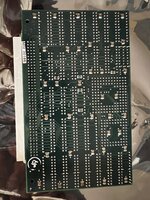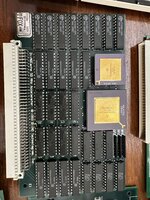-
Updated 2023-07-12: Hello, Guest! Welcome back, and be sure to check out this follow-up post about our outage a week or so ago.
You are using an out of date browser. It may not display this or other websites correctly.
You should upgrade or use an alternative browser.
You should upgrade or use an alternative browser.
Diimo Error chime?
- Thread starter macuserman
- Start date
Nixontheknight
Well-known member
that's a death chime, maybe a chip or two on the accelerator are badAny ideas on how to fix this? When I put this card in my IIci I get the normal chime followed by a funky chime.
macuserman
Well-known member
Ugh that's what I thought, but not sure where to troubleshoot on this thing. No Caps on it so that doesn't help.that's a death chime, maybe a chip or two on the accelerator are bad
zigzagjoe
Well-known member
Check for any obvious bad/ugly contacts on the connector and back of board first. If you're lucky it might be something simple. What is the history of the accelerator? Has it worked before?
If the simple stuff fails.... you're going to be getting into some fairly esoteric troubleshooting. Assuming the SE/30 design is a close relative of the IIci design (it definitely appears to be), I mainly experienced those weird slow chimes in my experience when there were clock issues. Such as a too slow or weak clock on the accelerator. If you have a quality multi-meter, measuring the average voltage of the top right pin of the crystal may give some useful info. Expect 2v or higher would be expected, 2.5v is ideal, and anything higher probably means the measurement is no good.
If you have a spare 30-50mhz crystal osc (anything in that range should work) you could swap out the one on there for troubleshooting purposes. Or even bodge something up, I used a RP2040 dev board as an adjustable clock generator for my experiments.
There are no caps that are critical to functionality, and if the buffers were bad it is improbable that it would come up enough to even make a death chime. Likewise the SRAM and TAG SRAM are not required to boot, so problem is unlikely to lie there.
Do you have any advanced troubleshooting tools such as a logic analyzer or an o-scope?
If the simple stuff fails.... you're going to be getting into some fairly esoteric troubleshooting. Assuming the SE/30 design is a close relative of the IIci design (it definitely appears to be), I mainly experienced those weird slow chimes in my experience when there were clock issues. Such as a too slow or weak clock on the accelerator. If you have a quality multi-meter, measuring the average voltage of the top right pin of the crystal may give some useful info. Expect 2v or higher would be expected, 2.5v is ideal, and anything higher probably means the measurement is no good.
If you have a spare 30-50mhz crystal osc (anything in that range should work) you could swap out the one on there for troubleshooting purposes. Or even bodge something up, I used a RP2040 dev board as an adjustable clock generator for my experiments.
There are no caps that are critical to functionality, and if the buffers were bad it is improbable that it would come up enough to even make a death chime. Likewise the SRAM and TAG SRAM are not required to boot, so problem is unlikely to lie there.
Do you have any advanced troubleshooting tools such as a logic analyzer or an o-scope?
Nixontheknight
Well-known member
iirc the SE/30 was based off of the iix, so it should be closeCheck for any obvious bad/ugly contacts on the connector and back of board first. If you're lucky it might be something simple. What is the history of the accelerator? Has it worked before?
If the simple stuff fails.... you're going to be getting into some fairly esoteric troubleshooting. Assuming the SE/30 design is a close relative of the IIci design (it definitely appears to be), I mainly experienced those weird slow chimes in my experience when there were clock issues. Such as a too slow or weak clock on the accelerator. If you have a quality multi-meter, measuring the average voltage of the top right pin of the crystal may give some useful info. Expect 2v or higher would be expected, 2.5v is ideal, and anything higher probably means the measurement is no good.
If you have a spare 30-50mhz crystal osc (anything in that range should work) you could swap out the one on there for troubleshooting purposes. Or even bodge something up, I used a RP2040 dev board as an adjustable clock generator for my experiments.
There are no caps that are critical to functionality, and if the buffers were bad it is improbable that it would come up enough to even make a death chime. Likewise the SRAM and TAG SRAM are not required to boot, so problem is unlikely to lie there.
Do you have any advanced troubleshooting tools such as a logic analyzer or an o-scope?
Phipli
Well-known member
I think you already have done some of these but I'd start by...
Deoxit the main connector, plus CPU and FPU sockets
Clean the board with ipa
Inspect the reverse side looking for scratches that cut traces or bad solder joints
Check for shorts across any capacitors Replace any electrolytics. Can't see any caps so guessing they're on the reverse? Or under chips?
Check the clock is running with a fast scope, freq counter or multimeter as above
Test it with a different CPU and FPU (simply because they're socketted)
If I was really stuck, I'd try desoldering the cache and tag RAM to see if it worked without, because that can fail... After that I'd worry it was a failed logic chip - do any get warmer than the rest?
Are all the logic chips soldered?
Deoxit the main connector, plus CPU and FPU sockets
Clean the board with ipa
Inspect the reverse side looking for scratches that cut traces or bad solder joints
Check for shorts across any capacitors Replace any electrolytics. Can't see any caps so guessing they're on the reverse? Or under chips?
Check the clock is running with a fast scope, freq counter or multimeter as above
Test it with a different CPU and FPU (simply because they're socketted)
If I was really stuck, I'd try desoldering the cache and tag RAM to see if it worked without, because that can fail... After that I'd worry it was a failed logic chip - do any get warmer than the rest?
Are all the logic chips soldered?
zigzagjoe
Well-known member
Sorry, good point: all of my post is in the context of the accelerator design, not the mac, though you are right about the similarity. I built a clone of the Diimo for SE/30, and I see functional analogs to the IIci board design where I'd expect to see them so I'm using that as a basis for troubleshooting.iirc the SE/30 was based off of the iix, so it should be close
Data SRAM and Tag SRAM is not required for the accelerator to boot (without the cache enabled via control panel). Unless things are bad to the point where the chip OE is not functioning as expected on data SRAM (ie. holding the accelerator's local data bus high/low), anyways.I think you already have done some of these but I'd start by...
Deoxit the main connector, plus CPU and FPU sockets
Clean the board with ipa
Inspect the reverse side looking for scratches that cut traces or bad solder joints
Check for shorts across any capacitors Replace any electrolytics. Can't see any caps so guessing they're on the reverse? Or under chips?
Check the clock is running with a fast scope, freq counter or multimeter as above
Test it with a different CPU and FPU (simply because they're socketted)
If I was really stuck, I'd try desoldering the cache and tag RAM to see if it worked without, because that can fail... After that I'd worry it was a failed logic chip - do any get warmer than the rest?
Are all the logic chips soldered?
As noted no critical capacitors on the card; they are all bypass caps and should be ceramic/tantalum.
Most likely issues involve either the main clock or the derivative phase-shift clock (U2 on the SE/30 board - may differ on this one, but it's easily identifiable). I want to say there was a case beyond out of range clock signal that I managed a similar symptom on, but I can't recall what it was immediately.
Now that I think about it, along with the good basic steps you have here, he may want to check PSU voltages also as these cards draw 5-10 watts and likely more on this older design. Might be enough to draw down 5v too much if it's a dodgy PSU.
macuserman
Well-known member
Yeah no real caps to speak of that can leak. Here’s a picture of the back.

I was actually going to try a different PSU and actually I was going to try it in my Mac II as well with the adapter just to see. I read somewhere where bolle mentioned something about having trouble with a diimo card of some kind in his IIci that worked in his Mac II.

I was actually going to try a different PSU and actually I was going to try it in my Mac II as well with the adapter just to see. I read somewhere where bolle mentioned something about having trouble with a diimo card of some kind in his IIci that worked in his Mac II.
macuserman
Well-known member
Ah yep here it is! I knew I had seen this, but it is for a slightly different card although sounds like his did more than mine. Reliability issues seems different than did not work at all.
It's the same as the SE/30 one, just a different form factor:
View attachment 37614
Never could get it to work reliably in the IIci though due to some (I suppose) timing issues.
It was fine in IIcx and II though as far as my testing went.
Phipli
Well-known member
Leaking isn't the only way caps fail. Ceramic caps like that can fail short, thats why I was saying check them with a meter.Yeah no real caps to speak of that can leak. Here’s a picture of the back.
View attachment 60717
I was actually going to try a different PSU and actually I was going to try it in my Mac II as well with the adapter just to see. I read somewhere where bolle mentioned something about having trouble with a diimo card of some kind in his IIci that worked in his Mac II.
macuserman
Well-known member
Fair enough can’t hurt to check them, just seems unlikely but easy enough to check.Leaking isn't the only way caps fail. Ceramic caps like that can fail short, thats why I was saying check them with a meter.
zigzagjoe
Well-known member
At this point the easy answer to both PSU and cap question is just check 5v, preferably near the PDS slot or you could even do so on the Diimo itself if you've a steady hand.
If it is below 4.8v or so, it bears further investigation, otherwise I'd say assume both are fine.
If it is below 4.8v or so, it bears further investigation, otherwise I'd say assume both are fine.
Similar threads
- Replies
- 22
- Views
- 1K
- Replies
- 4
- Views
- 295

